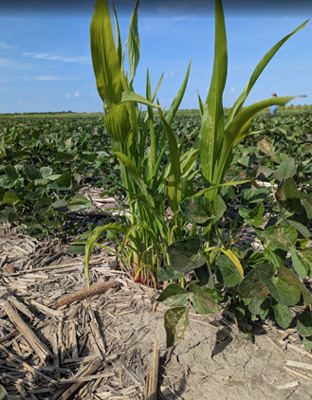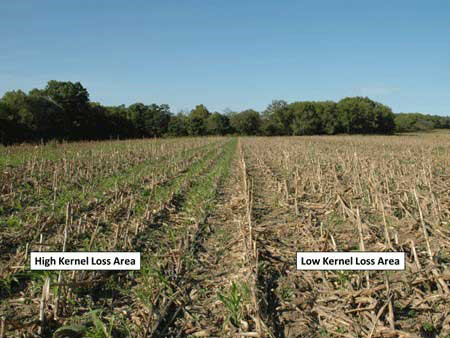Harvest inefficiency reduces overall yield and can cause future problems because of volunteer corn (Figure 1). Volunteer corn may have limited value in some systems with the potential of increasing the soil organic matter, providing cover to reduce soil erosion, or providing potential forage for grazing livestock. However, more often than not, volunteer corn becomes a problem for subsequent crops by acting as a weed, competing for soil moisture and nutrients, or as a “green bridge” for insects and disease.

Figure 1: Volunteer corn in a soybean field. Photo by Tina Sullivan, K-State Research and Extension.
Combine ground speed
Ground speed is one of the most important factors the operator controls that can improve harvest efficiency. Matching the ground speed to machine capacity and harvest conditions can improve harvest efficiency.
- Too fast: Increases losses at nearly all stages of harvest.
- Too slow: Reduces threshing efficiency and increases fuel use (gallons/bu).
Header loss
Header loss occurs when kernels never enter the machine, often due to lodged corn, overly dry ears, or improper header adjustments. Deck plates that are set too wide may cause excessive butt shelling of the ears. Adjusting both the header speed and relative ground speed can reduce header loss; slower may be better.
Measuring header loss
Harvest a portion of the field and then place a marker toward the rear of the combine and in front of the tailings discharge. Back the machine up so that the front of the header is even with the marker. Grain on the ground in the area between the header and the unharvested portion of the field is due to header loss. To determine the loss per acre, count the number of kernels or ears on the ground between the front of the combine and the unharvested corn and estimate the yield loss.
Adjustments to minimize header loss
- Adjust the gathering snouts so that the center snout is just touching the ground when the gathering chains are 2 inches above the ground. Working out from the center, each successive snout should be about 1 inch lower than the adjacent snout. Drive with the center snout just touching the ground. This will ensure that all snouts float at ground level when combining over rough ground.
- Gathering chains should extend at least ¼ inch beyond the snapping plate when measured at the front of the plate. Control chain speed so that stalks are guided into the rolls without uprooting.
- Snapping rolls should be set according to stalk thickness, with speed correlated closely to ground speed, so that the ear is snapped in the upper third of the roll. This helps reduce ear loss.
- Deck plates should be set as wide as possible without losing ears or shelling corn off the ear. This reduces the amount of trash taken into the machine. The spacing between the plates should be 1/8 to 3/16 inch tighter at the front of the plates than at the rear. In highly variable crop conditions, paying close attention to deck plate spacing has one of the largest potential paybacks. Newer headers with automatic or hydraulically actuated deck plates have the potential to significantly reduce header losses.
- Trash knives should usually be set as close to the rolls as possible to prevent wrapping.
Threshing loss and kernel damage
As with most other crops, cylinder or rotor adjustment has a great effect on corn quality. Up to 80% of kernel damage occurs during shelling. Moisture content greatly affects damage, with fines increasing rapidly at high moisture. If possible, delay harvest until moisture is between 20-25%.
Concave clearance and cylinder or rotor speed require careful adjustment, and although a great variation in hybrids exists, a few rules of thumb have been developed:
- Over-shelling the grain (by having the cylinder or rotor speed too high, or the clearance too tight) not only produces excess fines but also consumes excessive power and fuel.
- To adjust the cylinder or rotor, begin with the clearance and speed recommended by the manufacturer (or in the middle of the suggested range), then make small changes after checking the discharge of the machine.
Adjustments to minimize threshing loss and damage
- Set concave clearance so cobs fracture into halves or pie-shaped segments. If the cobs are broken into smaller halves or quartered pieces, higher cylinder or rotor speeds will be necessary to remove the grain, which in turn can contribute to grain damage, loss, and decreased sample quality.
- Reduce cylinder or rotor speed to the point that an occasional kernel is left on the cob. Several studies have shown that the best compromise between unshelled grain and excessive kernel damage occurs when about 0.2% of the kernels remain on the cob.
Keep in mind that the most significant contributing factor to grain damage is cylinder or rotor speed. In addition to grain damage, excessive cylinder or rotor speed can lead to increased levels of foreign material in the grain sample.
Sieve and chaffer settings
Machinery settings can affect grain losses at the sieve and chaffer. Grain losses may be reduced by adjusting fan speed.
- Fan speed too high: Kernels are blown out and lost.
- Fan speed too slow: Trash stays in the grain, leading to dockage.
- Adjust chaffer and sieve to minimize grain losses in the tailings. Yield losses from cleaning operations can be measured by counting kernels behind the combine. Especially look for windrowing effects if an adequate spreader is not used (Figure 2).

Figure 2. Windrowing effect from grain loss directly behind the combine. Photo by Gretchen Sassenrath, K-State Research and Extension.
Quantifying Harvest Loss
One way to quantify harvest loss is to identify an area of 10 ft2 behind the combine and count the number of kernels on the ground. In 30-inch row spacing, a length of 48 inches long by one inter-row spacing measures 10 ft2. Take the counted number of kernels in this area and divide by 20 to get an approximate loss in bushels per acre. Performing this at several locations across the harvest width and taking the average will give the most representative indication of overall loss.
Bottom Line
Now is the time to fine-tune and prepare harvest equipment. Losses also occur during transfer and handling, and volunteer corn may emerge later in the season, given adequate rainfall. While harvest losses in corn are more visible than in wheat or soybeans, the same principles apply. Proper combine adjustment means more grain in the bin and less on the ground.
Lucas Haag, Agronomist-in-Charge at Tribune
lhaag@ksu.edu
Tina Sullivan, Northeast Area Agronomist
tsullivan@ksu.edu
Logan Simon, Southwest Area Agronomist
lsimon@ksu.edu